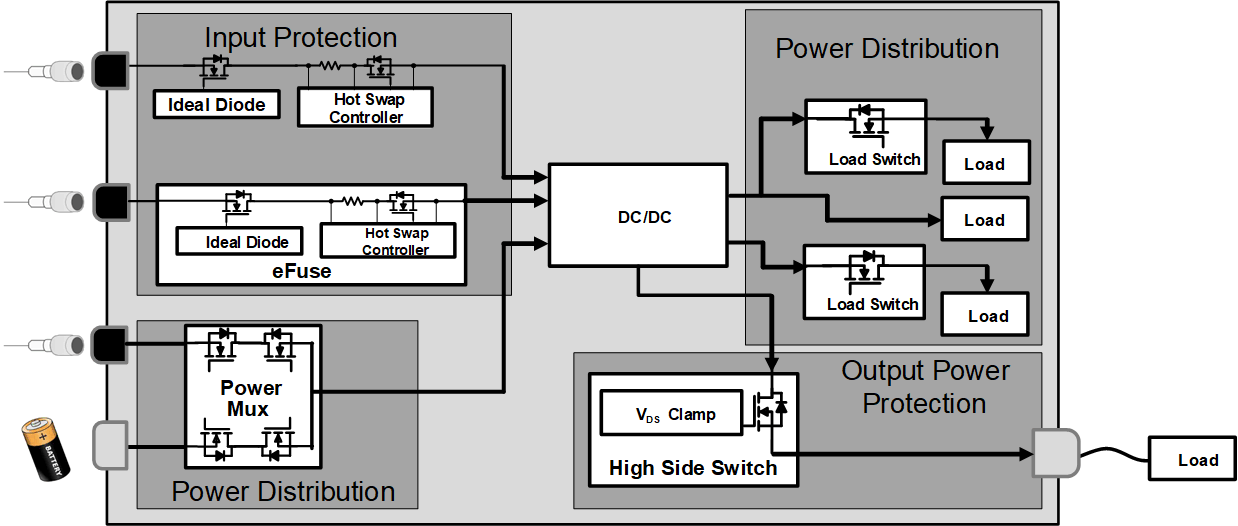SLVA927A November 2017 – April 2019 LM25066A , LM25066I , LM5050-1 , LM5051 , LM5064 , LM5066 , LM5067 , LM5069 , LM66100 , LM74500-Q1 , LM74700-Q1 , TPL7407LA , TPS1H100-Q1 , TPS1HA08-Q1 , TPS2113A , TPS2115A , TPS22810 , TPS22915 , TPS22916 , TPS22918 , TPS22971 , TPS22990 , TPS23525 , TPS2412 , TPS24751 , TPS24770 , TPS25942A , TPS2595 , TPS2660 , TPS27S100 , TPS2H160-Q1 , TPS4H160-Q1 , ULN2003A
Basics of Power Switches
A Power Switch provides an electrical connection from a voltage source or ground to a load. It saves power across multiple voltage rails and protects subsystems from damage. It also provides enhanced component protection, inrush current protection, and minimizes printed-circuit board (PCB) size.
There are several power switch topologies with different functions that address different applications. Load Switches establish the power switch foundation by providing safe and reliable distribution of power. Applications typically using load switches include power distribution, power sequencing, inrush current control, and reduced current leakage. Integrated Power MUX devices are similar to load switches but allow for multiple input sources. This set of electronic switches is used to select and transition between two or more input power paths to a single output while also providing input power protection.
eFuses and Hot Swap controllers provide additional input power path protection functions such as current sense monitoring, current limiting, undervoltage and overvoltage protection, and thermal shutdown. This makes these devices ideal for hot-plug and transient events that would otherwise damage system components. These benefits help reduce system maintenance costs and maximize equipment uptime.
Ideal diode, ORing controllers provide protection against reverse-polarity conditions by monitoring an external FET, significantly reducing power loss, and blocking reverse current. Whenever a transient event occurs, the controller monitors and adjusts the external FET to prevent damage to upstream components.
Smart high-side switches are for off-board load protection. They provide additional diagnostic telemetry that monitors the output load current and detects short-circuit and open-load events. Smart high-side switches have adjustable current limits, allowing for more reliable integration into applications with either large inrush current startup profiles or low peak currents. Adding a smart high-side switch to a design leads to a smarter and more robust solution for driving capacitive, inductive, and LED loads.
Low-side switches connect the load to ground instead of providing a connection between a power supply and the load. By including an integrated flyback diode, low-side switches help eliminate inductive load transients by dissipating current in a circular loop. This allows them to drive inductive loads such as solenoids, relays, and motors.
This application report highlights the different topologies within the power switch portfolio, and provides suggestions in choosing the correct solution for a faster design time.
Table 1. Power Switch Topology Table
| POWER DISTRIBUTION | POWER PATH PROTECTION | ||||||
|---|---|---|---|---|---|---|---|
| Load Switch | Power MUX
(2 input, 1 output) |
eFuse (Internal FET) | Hot Swap (External FET)
|
Ideal Diode
ORing Controller |
Smart High-Side Switch | Low-Side Switch | |
| Voltage Range | 0 V to 18 V | 2.8 V to 22 V | 2.7 V to 60 V | ±80 V | ±75 V | 6 V to 40 V | 0 V to 100 V |
| Max Operating Current | 15 A | 4.5 A | 15 A | N/A | N/A | 12 A | 1 A |
| Functions | |||||||
| Inrush Current Control | ✓ | ✓ | ✓ | ✓ | ✓ | ||
| Adjustable Current Limit | ✓ | ✓ | ✓ | ✓ | |||
| Reverse Current Blocking | ✓ | ✓ | ✓ | ✓ | ✓ | ||
| Current Sense Monitoring | ✓ | ✓ | ✓ | ||||
| Short-Circuit Protection | ✓(1) | ✓ | ✓ | ✓ | ✓ | ||
| Overvoltage Protection | ✓ | ✓ | ✓ | ||||
| Reverse Polarity Protection | ✓ | ✓ | ✓ | ✓ | ✓ | ||
| Power Good Signal | ✓ | ✓ | ✓ | ||||
| Inductive Load Compatibility | ✓ | ✓ | |||||
| Load-Dump Compatibility | ✓ | ✓ | ✓ | ✓ | ✓ | ||
| Thermal Shutdown | ✓ | ✓ | ✓ | ✓ | ✓ | ||
